Gimhongsok
Yukie Kamiya
Director of Hiroshima MOCA / The Curator’s Egg vol. 5, curator: Yukie Kamiya, theme: Extension-Expanding the Space of Artistic Expression)
(In every issue of “The Curator’s Egg,” one curator selects the artists and imagines an exhibition within the pages of the publication. “The Curator’s Egg” is to share the idea of curators and artists with the readers.
Gimhongsok’s works are both humorous and ironic. They take the form of unique tools or devices that are often combined with diverse art forms: installation, music, performance, and sometimes texts. The creator, Gimhongsok, plays many different roles depending on the situation: concept maker, coordinator, PR man, and entertainment manager. Bringing popular culture and art into the same arena, he uses familiar everyday elements products to attract viewers’ interest and question the role of the artist and the nature of art> He is engaged in a sincere exploration of the forms that can be taken by art in contemporary consumer society, dealing with the contradictions and conflicts that may exist under pleasant surficial appearances. Gimhongsok has created an oddly-shaped aluminum structure like a warped jungle gym which is a specialized device for producing virtual experiences of the dramatic poses taken by well-known athletes, like the freeze-frame photos of difficult or extraordinarily skillful moves by sports heroes that appear in magazines, newspapers, and other media. In Heromaniac (2000), anyone can experience these poses with the help of mountain climbing equipment (ropes, belts, and hooks) while holding onto the aluminum supports. First, an instructor wearing a helmet and projective gear demonstrates 36 different poses in front of audiences. These gravity-resisting poses include an overhead kick by a soccer player, a sideways jump to make a save by a goalkeeper, and a head-first slide by a baseball player. The somewhat outlandish costumes and performances are like a parody of television shopping advertisements. These works have a show business appeal that is thoroughly entertaining for the audience.
![]()
![]()
![]()
![]()
Heromaniac, 2000, performance, performed by O Dong
![]()
Heroic Poser, 2000, duralumin pipes, mountaineering equipments
– carabiner, descender, rope, pinwheel, climbing harness,
245 x 275 x 296 cm
Making a Star, shown at the same as Heromaniac, was a project in which the artist arranged for two young women scouted from karaoke bars to give a debut concert. Gimhongsok was heavily involved in all phases of the project as the producer/manager. He asked a composer to create new songs, participated in costume design, constructed the stage set, and made all the necessary arrangements for the debut performance, including PR. The singers performed before audiences of a gallery goers on a small, round stage with a stage set constructed of mirrors, which served as a metaphor for sculpture and two-dimensional art. To bring off this event, Gimhongsok collaborated with people playing many different roles, including singers, composers, recording and editing technicians, lighting and sound people, as he simulated the popular culture. The performance resembled a television show, a familiar code for the audience, more than theater. It did away with all the preconceptions of high art and erased the boundary between art and popular culture. It also contained elements of parody, presenting the exaggerated sort of competition and promotion common in a consumer economy.
![]()
Making a Star, 2000, performance, performed by Eunyoung Lee
In an age when vast amounts of information are being delivered by the media and people and things are constantly in motion, art exhibitions also become mobile and change from rather than staying fixed and stuck in one place. “Under Construction,” an exhibition that showcased art reflecting the everyday reality of Asia, moved from Seoul to Beijing and then to Tokyo. Gimhongsok’s contribution to this exhibition took the form of a boat, a vessel that moves. The body of the boat was a lurid blue that recalled the blue plastic tarps used on construction sites in Japan. It had the rough texture of stone on its outside surface and was filled with all sorts of everyday goods. The boat arrived empty at the exhibition space, where it was moored for the duration of the exhibition. It was loaded with products purchased locally, being completed as a work of art by the addition of objects unique to the place. The food and daily necessities purchased by the artist in nearby supermarkets and stores – local beer, instant ramen, magazines, music, perfume, etc. – were left as souvenirs for the museum staff after the exhibition when the boat embarked for the next port. In addition to food and consumables, the boat was loaded with such things as painted plates made for souvenirs, shades, illustrated books about fish, fishing poles, computers, and cell phones, everyday goods that might come in handy in urban life. Although there are plenty of provisions here, they are not the sort that would be useless on a real voyage. Ironically, things that are needed for urban life are not necessary for survival. Further irony is provided by the fact that this stone-like boat would sink before it went anyway on the water. It could only function as an art object. Gimhongsok used it to visually embody three aspects of contemporary society; nomadism, capitalism, and individualism.
![]()
![]()
![]()
The Boat, 2001, Polyester resin casting with urethane coating, audio equipment, loud speakers, kitchen utensils, a water bottle, a kerosene lamp, paddles, life floats, a bucket, rope, a fish net, a fishing pole, a towel, a seat cushion, and a parasol. Consumer goods: beer, a variety of canned food, instant noodles, snacks, vitamin pills, medicine bottles, sun tan cream, magazines, and CDs., Approx. 120 x 135 x 250 cm Installation view: Opera City Art Gallery, Tokyo, 2002
![]()
![]()
![]()
The Boat, 2001, Installation view: Kunstforeningen, Copenhagen, 2003
Gimhongsok is working on a plan, not yet executed to change this work into an automobile, a reflection of the motor age. In Give Me Gas, he plans to paint the boat with a commercially available automobile paint and recycle it as a car. He is thinking of color used on a model of the Volkswagen bus, Westphalia. This car, often used by hippies as a means of transportation and a place to stay, is an icon of nomadism and a symbol of freedom. When Gimhongsok paints the boat with the new color, Westphalia, it will move to the next exhibition as a car. The car does not need gas in order to express the condition of contemporary art nomads moving from exhibition to exhibition.
This work of art reflects a connection with society and turns attention toward in the complexity and great potential of the role of the artist who brings art and society together. The use of commercial products leads to a dialogue with regional factors. Gimhongsok explores elements that the artist does not or cannot control while putting Dadaist spontaneity and black humor into his works.
The Boat, 2001-2002
An empty boat was brought into the exhibition space where the artist filled it with locally purchased goods to complete the work. The loaded boat appeared ready to embark on a voyage. The products in the boat included beer, a fishing manual, a painted souvenirs plate, and internet equipment. There is irony in the fact that these items are useful for life in the modern city but not essential for survival in case of an emergency at sea.
Heromaniac, 2000
For this work, the artist produced the “heroic poser,” a structure that helps people get into the sort of dramatic poses taken by famous athletes. With this device, people can reproduce the actions of sports heroes in stop-motion, like the still photographs seen in magazines, posters, and other media. It is adaptable to all sorts of sports movements, including the overhead kick in soccer, a goal keeper’s punch, sliding into bases, and rock climbing.
Making a Star, 2000
In this project, the artist scouted two young singers in a karaoke bar and prepared them for a debut concert. This included having new songs written and giving lessons to the young singers before they appeared on stage. The artist took the role of manager, entering the system of popular culture by training the singers to be stars.
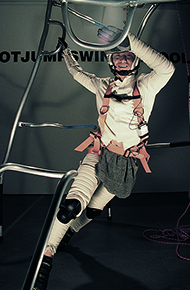
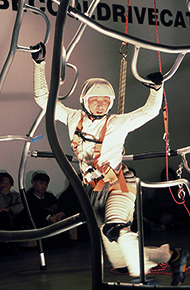

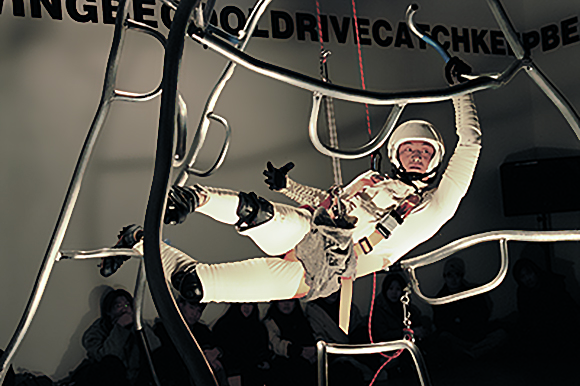
Heromaniac, 2000, performance, performed by O Dong
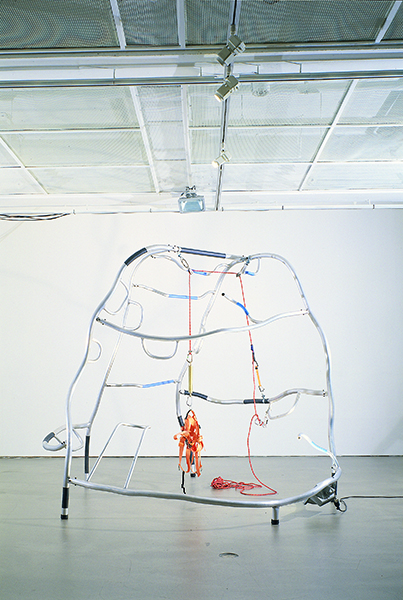
Heroic Poser, 2000, duralumin pipes, mountaineering equipments
– carabiner, descender, rope, pinwheel, climbing harness,
245 x 275 x 296 cm
Making a Star, shown at the same as Heromaniac, was a project in which the artist arranged for two young women scouted from karaoke bars to give a debut concert. Gimhongsok was heavily involved in all phases of the project as the producer/manager. He asked a composer to create new songs, participated in costume design, constructed the stage set, and made all the necessary arrangements for the debut performance, including PR. The singers performed before audiences of a gallery goers on a small, round stage with a stage set constructed of mirrors, which served as a metaphor for sculpture and two-dimensional art. To bring off this event, Gimhongsok collaborated with people playing many different roles, including singers, composers, recording and editing technicians, lighting and sound people, as he simulated the popular culture. The performance resembled a television show, a familiar code for the audience, more than theater. It did away with all the preconceptions of high art and erased the boundary between art and popular culture. It also contained elements of parody, presenting the exaggerated sort of competition and promotion common in a consumer economy.

Making a Star, 2000, performance, performed by Eunyoung Lee
In an age when vast amounts of information are being delivered by the media and people and things are constantly in motion, art exhibitions also become mobile and change from rather than staying fixed and stuck in one place. “Under Construction,” an exhibition that showcased art reflecting the everyday reality of Asia, moved from Seoul to Beijing and then to Tokyo. Gimhongsok’s contribution to this exhibition took the form of a boat, a vessel that moves. The body of the boat was a lurid blue that recalled the blue plastic tarps used on construction sites in Japan. It had the rough texture of stone on its outside surface and was filled with all sorts of everyday goods. The boat arrived empty at the exhibition space, where it was moored for the duration of the exhibition. It was loaded with products purchased locally, being completed as a work of art by the addition of objects unique to the place. The food and daily necessities purchased by the artist in nearby supermarkets and stores – local beer, instant ramen, magazines, music, perfume, etc. – were left as souvenirs for the museum staff after the exhibition when the boat embarked for the next port. In addition to food and consumables, the boat was loaded with such things as painted plates made for souvenirs, shades, illustrated books about fish, fishing poles, computers, and cell phones, everyday goods that might come in handy in urban life. Although there are plenty of provisions here, they are not the sort that would be useless on a real voyage. Ironically, things that are needed for urban life are not necessary for survival. Further irony is provided by the fact that this stone-like boat would sink before it went anyway on the water. It could only function as an art object. Gimhongsok used it to visually embody three aspects of contemporary society; nomadism, capitalism, and individualism.



The Boat, 2001, Polyester resin casting with urethane coating, audio equipment, loud speakers, kitchen utensils, a water bottle, a kerosene lamp, paddles, life floats, a bucket, rope, a fish net, a fishing pole, a towel, a seat cushion, and a parasol. Consumer goods: beer, a variety of canned food, instant noodles, snacks, vitamin pills, medicine bottles, sun tan cream, magazines, and CDs., Approx. 120 x 135 x 250 cm Installation view: Opera City Art Gallery, Tokyo, 2002
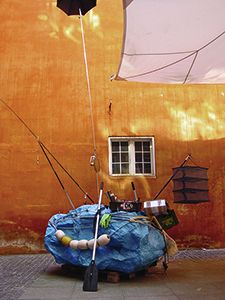
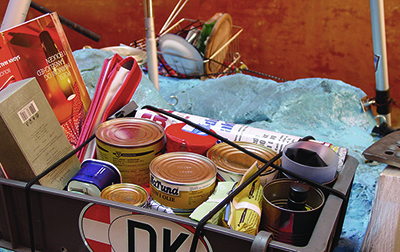

The Boat, 2001, Installation view: Kunstforeningen, Copenhagen, 2003
Gimhongsok is working on a plan, not yet executed to change this work into an automobile, a reflection of the motor age. In Give Me Gas, he plans to paint the boat with a commercially available automobile paint and recycle it as a car. He is thinking of color used on a model of the Volkswagen bus, Westphalia. This car, often used by hippies as a means of transportation and a place to stay, is an icon of nomadism and a symbol of freedom. When Gimhongsok paints the boat with the new color, Westphalia, it will move to the next exhibition as a car. The car does not need gas in order to express the condition of contemporary art nomads moving from exhibition to exhibition.
This work of art reflects a connection with society and turns attention toward in the complexity and great potential of the role of the artist who brings art and society together. The use of commercial products leads to a dialogue with regional factors. Gimhongsok explores elements that the artist does not or cannot control while putting Dadaist spontaneity and black humor into his works.
The Boat, 2001-2002
An empty boat was brought into the exhibition space where the artist filled it with locally purchased goods to complete the work. The loaded boat appeared ready to embark on a voyage. The products in the boat included beer, a fishing manual, a painted souvenirs plate, and internet equipment. There is irony in the fact that these items are useful for life in the modern city but not essential for survival in case of an emergency at sea.
Heromaniac, 2000
For this work, the artist produced the “heroic poser,” a structure that helps people get into the sort of dramatic poses taken by famous athletes. With this device, people can reproduce the actions of sports heroes in stop-motion, like the still photographs seen in magazines, posters, and other media. It is adaptable to all sorts of sports movements, including the overhead kick in soccer, a goal keeper’s punch, sliding into bases, and rock climbing.
Making a Star, 2000
In this project, the artist scouted two young singers in a karaoke bar and prepared them for a debut concert. This included having new songs written and giving lessons to the young singers before they appeared on stage. The artist took the role of manager, entering the system of popular culture by training the singers to be stars.